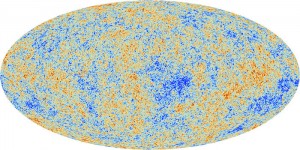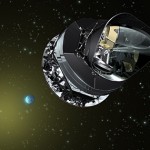Neutrinos leave mark on early universe
August 25th, 2015 @ 8:00 am by
Much of the time, popular stories about science emphasize the broader impact, the implications for the field, what it might mean for our lives. But in reality, science is often about finding that some detail of the universe works the way we had already predicted, and for scientists that's pretty cool too.
In one such discovery, UC Davis physicists have for the first time seen the signature of neutrinos spreading through the hot plasma of the early universe, at a time when light itself was still trapped in the plasma. The work is published in the journal Physical Review Letters.

The Planck sky map shows how neutrinos influenced the structure of the early universe. (ESA)
he Planck sky map shows how neutrinos influenced the structure of the early universe. (ESA)
he result, noted Professor Lloyd Knox, who lead the research team, was completely expected. Nonetheless, Knox said: "I feel really privileged that I got to lead the team that first detected this. It's like we've reached out and touched the Big Bang.â€
The only surprise was that the effect was detectable at all, Knox said.
Tens to hundreds of thousands of years after the Big Bang, before there were stars or galaxies, the universe was filled with super-hot plasma, hotter than the surface of the sun. Light particles (photons) could not make their way through the plasma, because they kept bumping off other particles.
But neutrinos could start flowing much earlier than light, because neutrinos interact very weakly with other particles.
Very small density variations led to acoustic waves in the plasma. Looking back today, we see those variations as ripples in the cosmic microwave background. Eventually, those variations - or anisotropies - would allow galaxies to form, giving structure to the universe.
Using data from the Planck space telescope, Knox and graduate students Brent Follin, Marius Millea and Zhen Pan looked for the gravitational influence of the neutrinos on these plasma waves. It had been predicted that the neutrinos would cause a very slight shift in the phase of the waves, and that is what they found: that the waves are just a little bit further along than they would be without the effect of neutrinos.
"It's one thing to predict it and talk about it, but then you look and it's there!†Knox said. "It's astounding.â€

The Planck Space Observatory
Launched in 2009 by the European Space Agency with NASA participation, the Planck telescope is positioned about a million miles from Earth to collect light from the beginnings of the universe. Knox leads the U.S. team analyzing Planck data to determine the basic parameters of the cosmos. The satellite has now stopped observations, but a final set of sky maps will be released next year, Knox said.
Read the paper: First detection of the acoustic oscillation phase shift expected from the cosmic neutrino background
What's a neutrino, anyways? (via the IceCube experiment, University of Wisconsin-Madison)
Published: September 10, 2015, 2:30 pm
